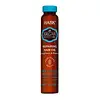What's inside
What's inside
 Key Ingredients
Key Ingredients

No key ingredients
 Benefits
Benefits

 Concerns
Concerns

 Ingredients Side-by-side
Ingredients Side-by-side

Cyclopentasiloxane
EmollientDimethiconol
EmollientArgania Spinosa Kernel Oil
EmollientKeratin Amino Acids
Skin ConditioningGlycine Soja Oil
EmollientVitis Vinifera Seed Oil
EmollientCitrus Aurantium Dulcis Oil
MaskingTocopherol
AntioxidantWater
Skin ConditioningButylene Glycol
HumectantPhenoxyethanol
PreservativeEthylhexylglycerin
Skin ConditioningCitral
PerfumingLimonene
PerfumingLinalool
PerfumingCI 26100
Cosmetic ColorantCI 47000
Cosmetic ColorantDimethicone
EmollientIsododecane
EmollientC12-15 Alkyl Benzoate
AntimicrobialArgania Spinosa Kernel Oil
EmollientItaconic Acid
AntimicrobialArginine
MaskingPanthenol
Skin ConditioningLinum Usitatissimum Seed Extract
PerfumingSalvia Hispanica Seed Extract
EmollientPolyglyceryl-10 Laurate
Skin ConditioningBenzyl Alcohol
PerfumingXylitol
HumectantCaprylic Acid
CleansingPolyglyceryl-2 Dipolyhydroxystearate
Skin ConditioningWater
Skin ConditioningParfum
MaskingAlpha-Isomethyl Ionone
PerfumingBenzyl Benzoate
AntimicrobialHexyl Cinnamal
PerfumingLimonene
PerfumingLinalool
PerfumingLinalyl Acetate
MaskingDimethicone, Isododecane, C12-15 Alkyl Benzoate, Argania Spinosa Kernel Oil, Itaconic Acid, Arginine, Panthenol, Linum Usitatissimum Seed Extract, Salvia Hispanica Seed Extract, Polyglyceryl-10 Laurate, Benzyl Alcohol, Xylitol, Caprylic Acid, Polyglyceryl-2 Dipolyhydroxystearate, Water, Parfum, Alpha-Isomethyl Ionone, Benzyl Benzoate, Hexyl Cinnamal, Limonene, Linalool, Linalyl Acetate
Ingredients Explained
These ingredients are found in both products.
Ingredients higher up in an ingredient list are typically present in a larger amount.
You may know this ingredient as argan oil. Argan Oil has antioxidant, hydrating, and soothing properties.
Studies have shown argan oil can help fight again radical damage from the sun. This makes it effective at preventing hyperpigmentation.
Large amounts of vitamin E found in argan oil helps the skin retain water. Argan oil also contains fatty acids such as linoleic acid, oleic acid, and palmitic acid. It is also a good source of lipids.
Another benefit of argan oil is skin-soothing. It can help reduce inflammation-related skin symptoms.
Argan Oil is effective at regulating sebum production in pores. This can make it effective at treating hormonal acne.
Traditionally, argan oil was used for its antibacterial and antifungal properties. However, argan oil contains fatty acids that may make it not fungal-acne safe.
Argan Trees are native to Morocco.
Learn more about Argania Spinosa Kernel OilLimonene is a fragrance that adds scent and taste to a formulation.
It's found in the peel oil of citrus fruits and other plants such as lavender and eucalyptus. The scent of limonene is generally described as "sweet citrus".
Limonene acts as an antioxidant, meaning it helps neutralize free radicals.
When exposed to air, oxidized limonene may sensitize the skin. Because of this, limonene is often avoided by people with sensitive skin.
The term 'fragrance' is not regulated in many countries. In many cases, it is up to the brand to define this term. For instance, many brands choose to label themselves as "fragrance-free" because they are not using synthetic fragrances. However, their products may still contain ingredients such as essential oils that are considered a fragrance.
Learn more about LimoneneLinalool is a fragrance and helps add scent to products. It's derived from common plants such as cinnamon, mint, citrus, and lavender.
Like Limonene, this ingredient oxidizes when exposed to air. Oxidized linalool can cause allergies and skin sensitivity.
This ingredient has a scent that is floral, spicy tropical, and citrus-like.
Learn more about LinaloolWater. It's the most common cosmetic ingredient of all. You'll usually see it at the top of ingredient lists, meaning that it makes up the largest part of the product.
So why is it so popular? Water most often acts as a solvent - this means that it helps dissolve other ingredients into the formulation.
You'll also recognize water as that liquid we all need to stay alive. If you see this, drink a glass of water. Stay hydrated!
Learn more about Water